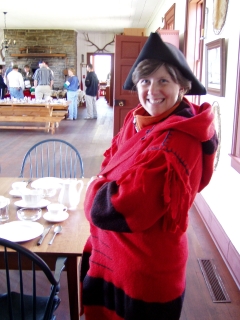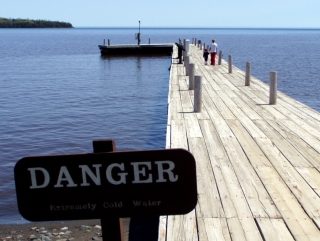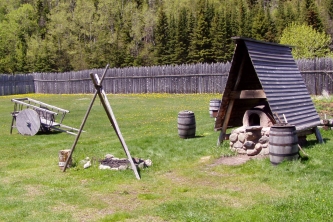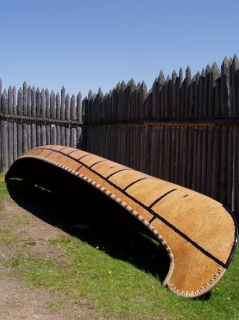Grand Portage National Monument
Grand Portage, Minn.
Visited: June 2, 2004
NPS Site Visited: 50 of 353
NPS Website; Local Website
 WHAT IS IT? WHAT IS IT?
A reconstructed fort/trading village that includes a great hall, canoe building warehouse, and kitchen. Grand Portage lies at an important geographical place; the site that connected the Great Lakes and cities of the east to the fur trapping lands of the northwest.
BEAUTY (6/10)
While the monument is enclosed entirely within Grand Portage Indian Reservation it does include the 8.2 mile Grand Portage Trail which extends through the scenic boreal forest from Grand Portage Bay to the Canadian border. The forest is gorgeous as are the views of Lake Superior. The reconstructed fort is nothing if not accurate.
HISTORIC SIGNIFICANCE (7/10)
Grand Portage NM is the real voyageurs site, as opposed to the nearby Voyageurs NP. Grand Portage NM marks and recreates the great summer fur trade Rendezvous. It also educates about the fur trade in general, canoe building and general 19th-century northwest life.
The site can be seen as a companion to the Salem Maritime NHP in Massachusetts. They both explain a similar period and experience in American life: the beginnings of international trade. Grand Portage NM, however, does a much better job.
 CROWDS (7/10) CROWDS (7/10)
Given Grand Portage NM’s recent opening and remoteness, we were surprised to find dozens of tourists at the Site. The crowd was happy, interested and full of questions. Perhaps they had come from the nearby slots-only Native American casino and needed to spark their brains. It worked.
EASE OF USE/ACCESS (1/5)
Located at the northeast tip of Minnesota. The Park is seasonal, opening on Memorial Day. We were there during its opening week.
CONCESSIONS/BOOKSTORE (5/5)
The superb bookstore includes colorful Voyageur-style belts and hats as well as hand-made ceramics and goods imprinted with the North West Trading Company logo. The book selection is also tremendous and the store was the first to include the highly informative 2004 edition of Fodor’s Official Guide to America’s National Parks; a necessary purchase given the extreme change in Parks’ operating hours since the book’s 2001 edition.
COSTS (3/5)
The cost is $3 per adult, $6 per family. The Site is free with the National Parks Pass.
RANGER/GUIDE TO TOURIST RATIO (5/5)
There were Rangers and volunteers everywhere. All were dressed in period costume so it was difficult to differentiate. In the Great Hall there were three people, two dressed as voyageurs, one dressed as a North West Company businessman.
There was a cook in the kitchen and a working canoe builder in the warehouse. They all knew so much. We spent nearly two and a half hours talking to them about the voyageurs, listening to their stories (mostly told in the first person) and asking questions.
 TOURS/CLASSES (10/10) TOURS/CLASSES (10/10)
One of the best yet. We especially enjoyed the discussions we had with both the cook and the canoe builder. The cook taught us about the intricacies of Minnesota wild rice. He even told us where to buy the “world’s best wild rice, a steal at $6 a pound”: nearby at the Grand Portage Trading Post and Post Office, run by the local Ojibwe Native Americans.
We learned what the North West Company executives ate during Rendezvous, what herbs were planted at the time, the history of the North West Company and its merger with the Hudson Bay Company and the environmental, political and conjugal effect the voyageur had on the region.
The cook was a wellspring of information, as was the canoe builder. He explained the trade routes, the canoe logistics, the canoe making process, the Rendezvous, the voyageur class system and so much more. Our guides were very skilled. They had the unique gift of being able to combine macro and micro issues into a living organic whole.
In addition, the self guided walking tour pamphlet, which seems at first superfluous, is one of the best we have seen so far. It culls even more information than the guides provide. Among other things, the pamphlet suggests books to further your knowledge, gives a handy North West Company timeline and describes a guided hiking trail over the 8.2 mile actual ‘Grand Portage’ from the Pigeon River to the site that borders Grand Portage Bay. The pamphlet is friendly and does not talk down to the reader; subsequently it is enjoyable to both adult and child, a rare feat.
Four videos are available for your viewing. We felt our time was better spent talking to the Rangers/volunteers. The planned Ojibwe Heritage Center will be a welcome addition in a Park Service seemingly bereft of Native Americans east of the Mississippi River.
 FUN (9/10) FUN (9/10)
As soon as we entered the Grand Portage fort, we stepped back in time. There is no Visitor Center, no welcome and nobody dressed as a Ranger. You immediately step into the Great Hall and must orient yourself to the year 1800. It is initially disorientating but ultimately a brilliant success.
You can touch sample pelts, dress as a voyageur, wear the beaver pelt top hats, watch a massive canoe being made, see flint lock rifle demonstrations and see an 18th-century garden.
These wonderful hands-on living history displays still take a back seat to the impressive and knowledgeable Grand Portage NM staff. Everything about the site was first rate. We had a great time.
WOULD WE RECOMMEND? (8/10)
A volunteer staffer told us that Grand Portage NM is not a “destination site”. That is a shame but not for good reason. It is in the middle of nowhere.
There are still many reasons to come to Grand Portage NM: 1) one of the three boats that travel to Isle Royale NP leaves two miles from Grand Portage NM; 2) the Boundary Waters Canoe Wilderness is very close and 3) the famed scenic drives up Highway 61 and up the Gunflint Trail are nearby.
If you find yourself doing any of these three things post-Memorial Day, come to Grand Portage NM. This Site is a hidden gem.
TOTAL 61/80
|